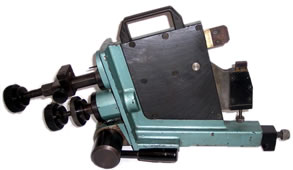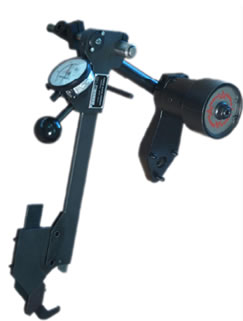 To obtain a superior finish on a crankshaft journal, all available equipment must be used to support the journal as it is being ground. Besides the headstock and tailstock, which are used to secure the crankshaft in the grinding machine, a steady rest and its shoes are used. If you look to the image to your left, you will see the side view of a Winona Van Norman steady rest and the shoes that come into direct contact with the crankshaft. Although the Winona Van Norman model pictured to the left does not have a dial indicator, most models accept this precision measuring device as an accessory.
To obtain a superior finish on a crankshaft journal, all available equipment must be used to support the journal as it is being ground. Besides the headstock and tailstock, which are used to secure the crankshaft in the grinding machine, a steady rest and its shoes are used. If you look to the image to your left, you will see the side view of a Winona Van Norman steady rest and the shoes that come into direct contact with the crankshaft. Although the Winona Van Norman model pictured to the left does not have a dial indicator, most models accept this precision measuring device as an accessory.
When grinding the rod journals, a steady rest is typically positioned to the side of the oil passage and tightened down to the grinding machine’s ways. Since the shoes ride directly on a journal, they must avoid the oil passage as a shoe may be drawn into the hole and damage the crankshaft and/or the equipment being used. Also, there must be adequate room for the operator to use the Arnold gauge to measure the amount of material being ground off. Especially on V6 crankshafts, where there is little side to side clearance, placing tooling and measuring devices on the journal at the same time can be quite a challenge. Once properly positioned, safely to the side of any oil passages and with plenty of room for the Arnold gauge, the automotive machinist then slowly tightens up the steady rest so that it supports the journal as it is being ground. As the machinist takes off more material, the arms are slowly tightened even more so that shoes remain snug to the journal throughout the entire grinding process. The steady rest is the one tool that resists the force created from the grinding wheel as it is slowly fed into the journal, which is an important function to produce finished journals of the proper size and microfinish. Continue reading →
 Since crankshaft grinding wheels are extremely hard and abrasive, a special tool is required to dress the wheel. This tool, which is commonly called the wheel dresser, utilizes an industrial diamond for cutting the wheel’s stone. Not surprisingly, there are various sizes of diamonds that are used and categorized according to their carat weight.
Since crankshaft grinding wheels are extremely hard and abrasive, a special tool is required to dress the wheel. This tool, which is commonly called the wheel dresser, utilizes an industrial diamond for cutting the wheel’s stone. Not surprisingly, there are various sizes of diamonds that are used and categorized according to their carat weight. The Arnold gauge, which is pictured left, is not only used in automotive machine shops. Many different industries, such as those involved with manufacturing aerospace and aviation components, rely on an Arnold gauge for a variety of O.D. grinding operations. With an accuracy of .0001”, it is quite easy to see why so many machinists are pleased with how well this gauge performs. Besides being accurate, an Arnold Gauge is also very easy for an operator to use.
The Arnold gauge, which is pictured left, is not only used in automotive machine shops. Many different industries, such as those involved with manufacturing aerospace and aviation components, rely on an Arnold gauge for a variety of O.D. grinding operations. With an accuracy of .0001”, it is quite easy to see why so many machinists are pleased with how well this gauge performs. Besides being accurate, an Arnold Gauge is also very easy for an operator to use.  To obtain a superior finish on a crankshaft journal, all available equipment must be used to support the journal as it is being ground. Besides the headstock and tailstock, which are used to secure the crankshaft in the grinding machine, a steady rest and its shoes are used. If you look to the image to your left, you will see the side view of a Winona Van Norman steady rest and the shoes that come into direct contact with the crankshaft. Although the Winona Van Norman model pictured to the left does not have a dial indicator, most models accept this precision measuring device as an accessory.
To obtain a superior finish on a crankshaft journal, all available equipment must be used to support the journal as it is being ground. Besides the headstock and tailstock, which are used to secure the crankshaft in the grinding machine, a steady rest and its shoes are used. If you look to the image to your left, you will see the side view of a Winona Van Norman steady rest and the shoes that come into direct contact with the crankshaft. Although the Winona Van Norman model pictured to the left does not have a dial indicator, most models accept this precision measuring device as an accessory.